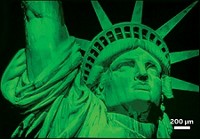Advertisement
Grab your lab coat. Let's get started
Welcome!
Welcome!
Create an account below to get 6 C&EN articles per month, receive newsletters and more - all free.
It seems this is your first time logging in online. Please enter the following information to continue.
As an ACS member you automatically get access to this site. All we need is few more details to create your reading experience.
Not you? Sign in with a different account.
Not you? Sign in with a different account.
ERROR 1
ERROR 1
ERROR 2
ERROR 2
ERROR 2
ERROR 2
ERROR 2
Password and Confirm password must match.
If you have an ACS member number, please enter it here so we can link this account to your membership. (optional)
ERROR 2
ACS values your privacy. By submitting your information, you are gaining access to C&EN and subscribing to our weekly newsletter. We use the information you provide to make your reading experience better, and we will never sell your data to third party members.
Spectroscopy
Sound waves levitate chemistry
Merging droplets in air for precise control and unobstructed analysis
by Sam Lemonick
June 5, 2020
| A version of this story appeared in
Volume 98, Issue 22

Researchers have built a levitation device to help them make precise measurements of chemical reactions (Anal. Chem. 2020, DOI: 10.1021/acs.analchem.0c00929). Levitating droplets on sound waves allows Stephen J. Brotton and Ralf I. Kaiser of the University of Hawaiʻi at Mānoa to precisely control the amount and temperature of reagents, eliminates the effects that a flask’s surface might have on a reaction, and gives an unobstructed view of the reaction for analysis via spectroscopy. Bringing two substances together like this is chemistry at its most basic, Brotton says. They adapted an ultrasonic levitator to create pockets of different air pressure that will hold droplets, one above the other. By changing the sound waves from the levitator, Brotton and Kaiser induced the upper droplet to stretch and merge with the droplet below. They demonstrated an acid-base reaction, spontaneous combustion of rocket propellants, and coalescence of a liquid droplet and solid crystals. They measured reactions using Raman, Fourier-transform infrared, and ultraviolet−visible spectroscopies. Other techniques for merging droplets rely on lasers or electromagnetic forces, but Kaiser says those methods only work with certain chemicals, while their acoustic device is material agnostic. The equipment could be used to study reactions in the atmosphere or on other planets, or for medical chemistry using very small sample sizes. But since the levitator relies on air pressure, it cannot be used to study reactions in a vacuum.




Join the conversation
Contact the reporter
Submit a Letter to the Editor for publication
Engage with us on Twitter